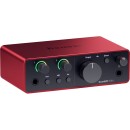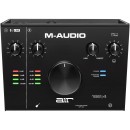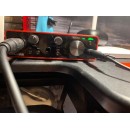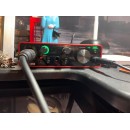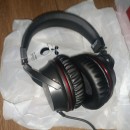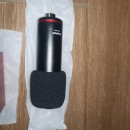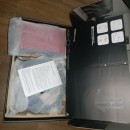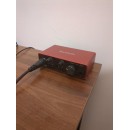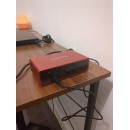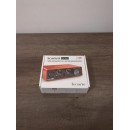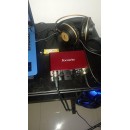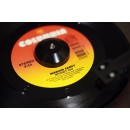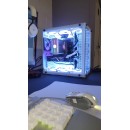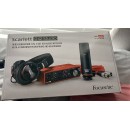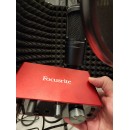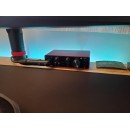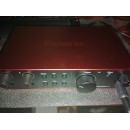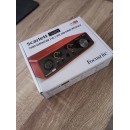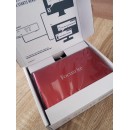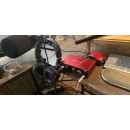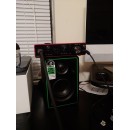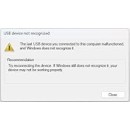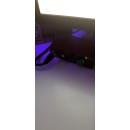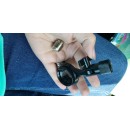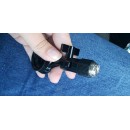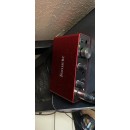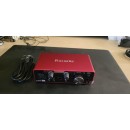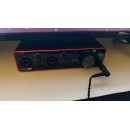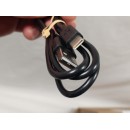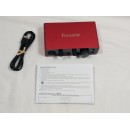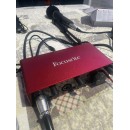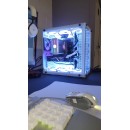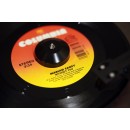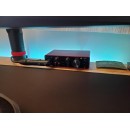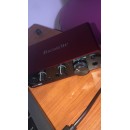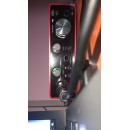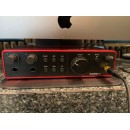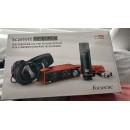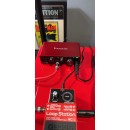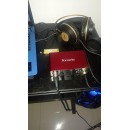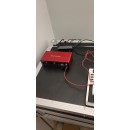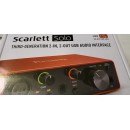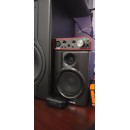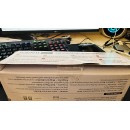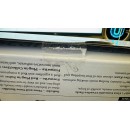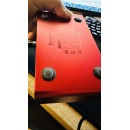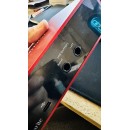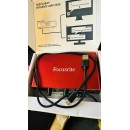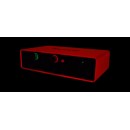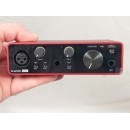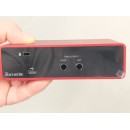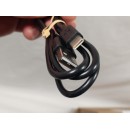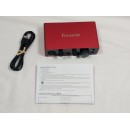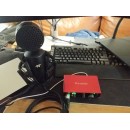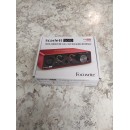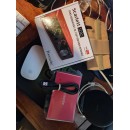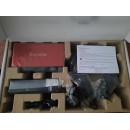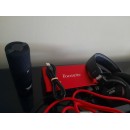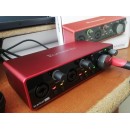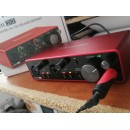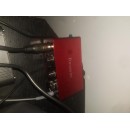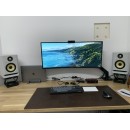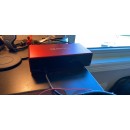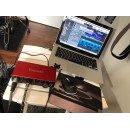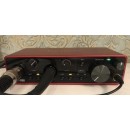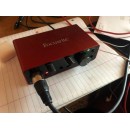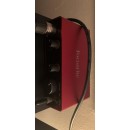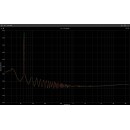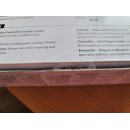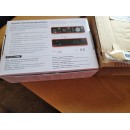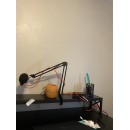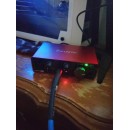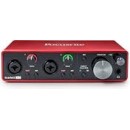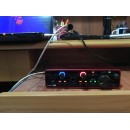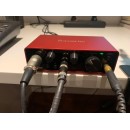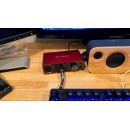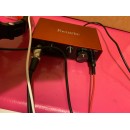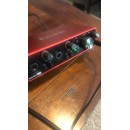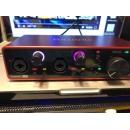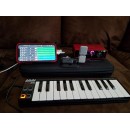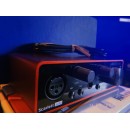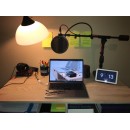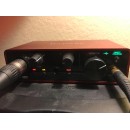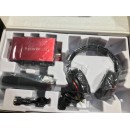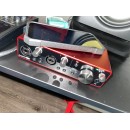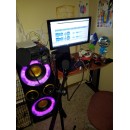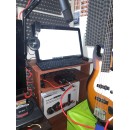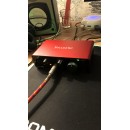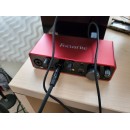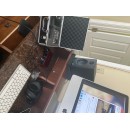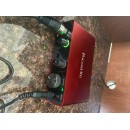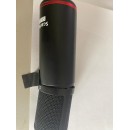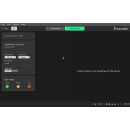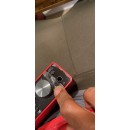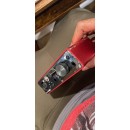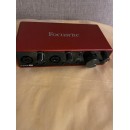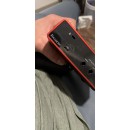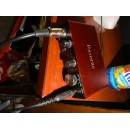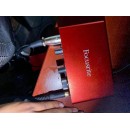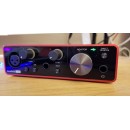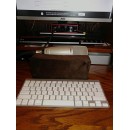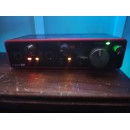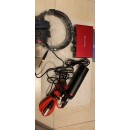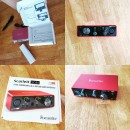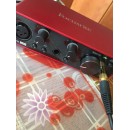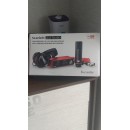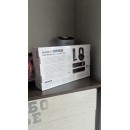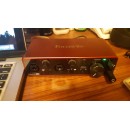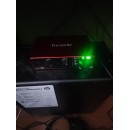M-Audio AIR 192|4 vs Focusrite Scarlett Solo 4th Gen: In-Depth Comparison
The Focusrite Scarlett Solo (4th Gen) is renowned for its exceptional sound quality and user-friendly design. It features a single upgraded Scarlett mic preamp with switchable Air mode to give your recordings a brighter, more open sound. The unit also includes a high-headroom instrument input for guitars and basses, as well as balanced outputs for clean audio playback. The Scarlett Solo is compact, making it highly portable, and is powered via USB-C, ensuring low latency and high-speed data transfer. The interface comes with a comprehensive software bundle, including Ableton Live Lite and Pro Tools First, providing all the tools needed to start recording right away.
On the other hand, the M-Audio AIR 192|4 offers a bit more flexibility with its 2x2 configuration, allowing for simultaneous recording of vocals and instruments. It boasts a high-speed USB-C connection for ultra-low latency and pristine audio quality, with a 24-bit/192 kHz resolution. The interface includes Crystal preamps and pristine A/D converters, ensuring transparent sound. It also features a large central volume knob for easy control and LED VU meters for accurate level monitoring. The AIR 192|4 comes with a robust software suite, including Pro Tools First, Ableton Live Lite, and Eleven Lite, among others, providing a versatile toolkit for various recording needs.
In summary, the Focusrite Scarlett Solo (4th Gen) is ideal for solo musicians and podcasters looking for a high-quality, straightforward interface with excellent sound quality. Its portability and simple setup make it a great choice for those who need to record on the go. Meanwhile, the M-Audio AIR 192|4 offers more input flexibility and additional control features, making it suitable for users who require the ability to record multiple sources simultaneously and prefer more hands-on control over their recording levels. Both interfaces are excellent, but your choice should depend on your specific recording needs and workflow preferences.
Specifications, Advantages, and Disadvantages
| User Rating Based on Analysis of Reviews | |
|---|---|
|
Show More |
| Pros: | |
|---|---|
|
|
| Cons: | |
|---|---|
|
|
| Key Specs | |
|---|---|
| Channels of I/O | |
| Analog: 2 Inputs / 2 Outputs at 192 kHz |
Analog: 2 Inputs / 2 Outputs at 192 kHz |
| Maximum Sampling Rate | |
| 192 kHz / 24-Bit | 192 kHz / 24-Bit |
| Number of Microphone Inputs | |
| 1 | 1 Preamp |
| Analog Audio I/O | |
| 1x XLR 3-Pin Balanced Mic Input 1x 1/4" TS Unbalanced Line/Hi-Z Input (Front Panel) 2x 1/4" TRS Balanced Monitor Output 1x 1/4" TRS Headphone Output (Front Panel) |
1x Combo XLR-1/4" TRS Balanced Mic/Line Input 1x 1/4" TS Unbalanced Hi-Z Input (Front Panel) 2x 1/4" TRS Balanced Line Output 1x 1/4" TRS Unbalanced Headphone Output (Front Panel) |
| Host Connection | |
| 1x USB-C | 1x USB-C (Class-Compliant) |
| OS Compatibility | |
| macOS Windows |
macOS 10.8 or Later Windows 7 or Later |
| Power Requirements | |
| USB Bus Power, USB Power Adapter (Not Included) | USB Bus Power |
Channels of I/O: Both interfaces offer 2 analog inputs and 2 analog outputs, supporting high-resolution audio at 192 kHz.
Maximum Sampling Rate: Each device supports a maximum sampling rate of 192 kHz / 24-bit, ensuring professional-grade audio quality.
Number of Microphone Inputs: Both interfaces come with 1 microphone input. The Focusrite Scarlett Solo utilizes a single XLR 3-pin balanced mic input, while the M-Audio AIR 192|4 features a combo XLR-1/4" TRS balanced mic/line input, offering more flexibility for connecting different types of microphones or line-level signals.
Analog Audio I/O: The Focusrite Scarlett Solo has 1 XLR 3-pin balanced mic input, 1 1/4" TS unbalanced line/Hi-Z input, 2 1/4" TRS balanced monitor outputs, and 1 1/4" TRS headphone output on the front panel.
The M-Audio AIR 192|4 includes 1 combo XLR-1/4" TRS balanced mic/line input, 1 1/4" TS unbalanced Hi-Z input, 2 1/4" TRS balanced line outputs, and 1 1/4" TRS unbalanced headphone output on the front panel. The combo input on the M-Audio AIR 192|4 provides added versatility for connecting different types of sources.
Digital Audio I/O: Neither interface offers digital audio I/O, focusing instead on analog connectivity.
Host Connection: Both interfaces use a USB-C connection for communication with the host computer. The M-Audio AIR 192|4 is class-compliant, meaning it requires no additional drivers for macOS 10.8 or later and Windows 7 or later. The Focusrite Scarlett Solo also supports macOS and Windows operating systems.
Power Requirements: Both interfaces are USB bus-powered, which means they draw power directly from the connected USB port, eliminating the need for an external power supply. However, the Focusrite Scarlett Solo also mentions the option to use a USB power adapter, although it is not included.
In summary, while both the Focusrite Scarlett Solo USB-C Audio Interface (4th Generation) and the M-Audio AIR 192|4 Desktop 2x2 USB Type-C Audio Interface share many similarities in terms of I/O channels, sampling rate, and power requirements, the M-Audio AIR 192|4 offers a more versatile combo input and class-compliant USB-C connection. The Focusrite Scarlett Solo, on the other hand, remains a robust choice with its dedicated mic and line/Hi-Z inputs and balanced monitor outputs.
| General | |
|---|---|
| Channels of I/O | |
| Analog: 2 Inputs / 2 Outputs at 192 kHz |
Analog: 2 Inputs / 2 Outputs at 192 kHz |
| Maximum Sampling Rate | |
| 192 kHz / 24-Bit | 192 kHz / 24-Bit |
| Number of Microphone Inputs | |
| 1 | 1 Preamp |
| Input Level Adjustment | |
| 2x Knob | 2x Knob |
| Expansion Slots | |
The Focusrite Scarlett Solo provides 2 analog inputs and 2 analog outputs, with a maximum sampling rate of 192 kHz at 24-bit resolution. It features one microphone input and does not include a built-in microphone or expansion slots. The input level adjustment is managed via two knobs. Notably, the Scarlett Solo does not come with built-in DSP (Digital Signal Processing).
Similarly, the M-Audio AIR 192|4 offers 2 analog inputs and 2 analog outputs, matching the same maximum sampling rate of 192 kHz at 24-bit resolution. It also includes a single microphone input with a preamp and does not have a built-in microphone or expansion slots. The input level adjustment is likewise controlled through two knobs.
Both interfaces provide equivalent input and output channels, sampling rates, and input level adjustment mechanisms. However, a key difference is that the Scarlett Solo does not incorporate built-in DSP, which may be a consideration depending on your need for real-time audio processing capabilities.
| Signal Processing | |
|---|---|
| Gain/Trim Range | |
| Mic/Line Inputs: Up to +69 dB Hi-Z Inputs: 62 dB |
Mic/Line Inputs: 55 dB Hi-Z Inputs: 24 dB |
In comparison, the M-Audio AIR 192|4 Desktop 2x2 USB Type-C Audio Interface has a more limited gain/trim range. Its mic/line inputs offer a gain/trim range of 55 dB, which, while sufficient for many applications, is less accommodating than that of the Focusrite Scarlett Solo. The Hi-Z inputs on the M-Audio AIR 192|4 provide a gain/trim range of 24 dB, significantly lower than the Focusrite's 62 dB, potentially limiting its effectiveness with certain high-impedance instruments.
Furthermore, the M-Audio AIR 192|4 lacks features such as a pad, a high-pass filter, and solo/mute options. These omissions could impact its flexibility and control in various recording scenarios. The absence of a pad means it may be more challenging to handle high-level input sources without distortion. The lack of a high-pass filter means users won't be able to easily eliminate low-frequency rumble or noise directly on the interface. Lastly, the absence of solo/mute functions may limit its usability in more complex monitoring setups.
Overall, the Focusrite Scarlett Solo USB-C Audio Interface (4th Generation) appears to provide a broader and more versatile gain range, making it a potentially more robust choice for users requiring flexibility and higher input sensitivity. In contrast, the M-Audio AIR 192|4, while still a competent interface, may be more limited in terms of gain handling and additional features.
| Connectivity | |
|---|---|
| Analog Audio I/O | |
| 1x XLR 3-Pin Balanced Mic Input 1x 1/4" TS Unbalanced Line/Hi-Z Input (Front Panel) 2x 1/4" TRS Balanced Monitor Output 1x 1/4" TRS Headphone Output (Front Panel) |
1x Combo XLR-1/4" TRS Balanced Mic/Line Input 1x 1/4" TS Unbalanced Hi-Z Input (Front Panel) 2x 1/4" TRS Balanced Line Output 1x 1/4" TRS Unbalanced Headphone Output (Front Panel) |
| Phantom Power | |
| 48 V, Selectable On/Off | 48 V, Selectable On/Off |
| Digital Audio I/O | |
| Host Connection | |
| 1x USB-C | 1x USB-C (Class-Compliant) |
| Host Connection Protocol | |
| USB 2.0 | USB 2.0 |
| USB (Non-Host) | |
| Sync I/O | |
| Network I/O | |
| MIDI I/O | |
In terms of analog audio I/O, the Focusrite Scarlett Solo provides a straightforward setup with 1x XLR 3-pin balanced mic input, 1x 1/4" TS unbalanced line/Hi-Z input on the front panel, 2x 1/4" TRS balanced monitor outputs, and 1x 1/4" TRS headphone output on the front panel. The M-Audio AIR 192|4 offers a bit more versatility with a combo XLR-1/4" TRS balanced mic/line input, 1x 1/4" TS unbalanced Hi-Z input on the front panel, 2x 1/4" TRS balanced line outputs, and 1x 1/4" TRS unbalanced headphone output on the front panel. The combo input on the M-Audio adds flexibility for users who may need to switch between XLR and TRS connections for their microphone or line inputs.
Both interfaces are equipped with 48 V phantom power, which is selectable on or off, allowing the use of condenser microphones that require external power.
Regarding digital connectivity, neither the Focusrite Scarlett Solo nor the M-Audio AIR 192|4 offers digital audio I/O, sync I/O, network I/O, or MIDI I/O, which makes them more streamlined options primarily focused on analog audio recording.
For host connections, both interfaces use 1x USB-C, adhering to the USB 2.0 protocol, ensuring compatibility with modern computers and providing sufficient speed for their audio processing needs. Neither device supports additional USB (non-host) connections.
In summary, while both audio interfaces share many similarities in terms of their USB-C connectivity, phantom power capabilities, and lack of digital and network I/O, the M-Audio AIR 192|4 stands out with its combo input offering more input flexibility. On the other hand, the Focusrite Scarlett Solo maintains a straightforward and efficient design, making it a solid choice for users needing a simple yet effective recording solution.
| Performance | |
|---|---|
| Frequency Response | |
| XLR Mic Inputs: 20 Hz to 20 kHz ±0.06 dB 1/4" Line Inputs: 20 Hz to 20 kHz 0.05 dB 1/4" Hi-Z Inputs: 20 Hz to 20 kHz 0.15 dB |
Mic Inputs: 20 Hz to 20 kHz +0.1 dB Line, Hi-Z Inputs: 20 Hz to 20 kHz ±0.05 dB Monitor Outputs: 20 Hz to 20 kHz +0.06 dB |
| Maximum Input Level | |
| XLR Mic: 9.5 dBu 1/4" Line: 22 dBu 1/4" Hi-Z: 12 dBu |
Mic Inputs: +1.5 dBu Line Inputs: +16 dBu Hi-Z Inputs: +6 dBu |
| Maximum Output Level | |
| 1/4" Line: +16 dBu |
Line Outputs: +7 dBu (Balanced, 1 kHz) |
| Impedance | |
| XLR Mic Inputs: 3 Kilohms 1/4" Line Inputs: 60 Kilohms 1/4" Hi-Z Inputs: 1 Megohms 1/4" Line Outputs: 200 Ohms 1/4" Headphone Outputs: < 50 Ohm |
Hi-Z Inputs: 1 Megohm (Unbalanced) Headphone Outputs: 10 Ohms (Balanced) |
| Dynamic Range | |
| XLR Mic Inputs: 113 dBA 1/4" Line Inputs: 113 dBA 1/4" Hi-Z Inputs: 112 dBA 1/4" Line Outputs: 120 dB 1/4" Headphone: 112 dB (at 33 Ohms) 115 dB (at 300 Ohms) Digital A/D Converters: 120 dB Digital D/A Converters: 130 dBA |
Mic Inputs: 104 dB (A-Weighted) Hi-Z Inputs: 100 dB (A-Weighted) Monitor Outputs: 102 dB (A-Weighted) |
| THD+N | |
| XLR Mic Inputs: -100 dB (at Minimum Gain) 1/4" Line Inputs: -100 dB (at 8 dB Gain) 1/4" Hi-Z Inputs: -80 dB (at Minimum Gain) 1/4" Line Outputs: -100 dB (at Minimum Gain) 1/4" Headphone Outputs: -97 dB (at 33 Ohms) -102 dB (at 300 Ohms) Digital A/D Converters: -110 dB Digital D/A Converters: -115 dB |
Mic/Line Inputs: 0.003% Hi-Z Inputs: 0.004% Headphone/Monitor Outputs: 0.005% |
| EIN | |
| XLR Mic Inputs: -127 dBu A-Weighted |
Mic Inputs: -128 dBu A-Weighted (150-Ohm Source, Max Gain) |
In terms of frequency response, the Focusrite Scarlett Solo boasts XLR Mic Inputs with a range of 20 Hz to 20 kHz ±0.06 dB, 1/4" Line Inputs at 20 Hz to 20 kHz ±0.05 dB, and 1/4" Hi-Z Inputs at 20 Hz to 20 kHz ±0.15 dB. The M-Audio AIR 192|4 offers Mic Inputs with a frequency response of 20 Hz to 20 kHz +0.1 dB, Line and Hi-Z Inputs at 20 Hz to 20 kHz ±0.05 dB, and Monitor Outputs at 20 Hz to 20 kHz +0.06 dB.
Regarding maximum input levels, the Focusrite Scarlett Solo accommodates XLR Mic Inputs up to 9.5 dBu, 1/4" Line Inputs up to 22 dBu, and 1/4" Hi-Z Inputs up to 12 dBu. The M-Audio AIR 192|4 supports Mic Inputs up to +1.5 dBu, Line Inputs up to +16 dBu, and Hi-Z Inputs up to +6 dBu. For maximum output levels, the Focusrite Scarlett Solo has 1/4" Line Outputs at +16 dBu, while the M-Audio AIR 192|4 provides Line Outputs at +7 dBu (Balanced, 1 kHz).
The headphone output power for the Focusrite Scarlett Solo is 32 mW into 33 Ohms and 22 mW into 300 Ohms, whereas the M-Audio AIR 192|4 does not specify the output power in its provided specifications but lists the headphone output impedance at 10 Ohms (Balanced).
In impedance, the Focusrite Scarlett Solo features XLR Mic Inputs at 3 Kilohms, 1/4" Line Inputs at 60 Kilohms, 1/4" Hi-Z Inputs at 1 Megohm, 1/4" Line Outputs at 200 Ohms, and 1/4" Headphone Outputs at less than 50 Ohms. The M-Audio AIR 192|4 has Hi-Z Inputs at 1 Megohm (Unbalanced) and Headphone Outputs at 10 Ohms (Balanced).
Dynamic range and signal-to-noise ratio (SNR) show significant differences. The Focusrite Scarlett Solo offers XLR Mic Inputs at 113 dBA, 1/4" Line Inputs at 113 dBA, 1/4" Hi-Z Inputs at 112 dBA, 1/4" Line Outputs at 120 dB, 1/4" Headphone Outputs at 112 dB (at 33 Ohms) and 115 dB (at 300 Ohms), Digital A/D Converters at 120 dB, and Digital D/A Converters at 130 dBA. The M-Audio AIR 192|4 has Mic Inputs at 104 dB (A-Weighted), Hi-Z Inputs at 100 dB (A-Weighted), Monitor Outputs at 102 dB (A-Weighted), and SNR for Mic Inputs at 104 dB (A-Weighted), Line Inputs at 101 dB (A-Weighted), Hi-Z Inputs at 102 dB (A-Weighted), and Monitor Outputs at 102 dB (A-Weighted).
The total harmonic distortion plus noise (THD+N) for the Focusrite Scarlett Solo is XLR Mic Inputs at -100 dB (at Minimum Gain), 1/4" Line Inputs at -100 dB (at 8 dB Gain), 1/4" Hi-Z Inputs at -80 dB (at Minimum Gain), 1/4" Line Outputs at -100 dB (at Minimum Gain), and 1/4" Headphone Outputs at -97 dB (at 33 Ohms) and -102 dB (at 300 Ohms), with Digital A/D Converters at -110 dB and Digital D/A Converters at -115 dB. The M-Audio AIR 192|4 lists its THD+N for Mic/Line Inputs at 0.003%, Hi-Z Inputs at 0.004%, and Headphone/Monitor Outputs at 0.005%.
Finally, the equivalent input noise (EIN) for the Focusrite Scarlett Solo is -127 dBu A-Weighted for XLR Mic Inputs, while the M-Audio AIR 192|4 has an EIN of -128 dBu A-Weighted for Mic Inputs (150-Ohm Source, Max Gain).
These differences highlight the strengths and weaknesses of each interface, catering to different needs and preferences of audio professionals and enthusiasts.
| Digital Audio | |
|---|---|
| Sample Rates | |
| 44.1 / 48 / 88.2 / 96 / 176.4 / 192 kHz | Up to 192 kHz (AD/DA Conversion) |
| Bit Depths | |
| 24-Bit | 24-Bit (AD/DA Conversion) |
| Sync Sources | |
| Internal | Internal |
The Focusrite Scarlett Solo offers a range of sample rates including 44.1, 48, 88.2, 96, 176.4, and 192 kHz, providing flexibility for different recording and production requirements. It supports a bit depth of 24-bit, ensuring high-resolution audio quality. The device uses internal sync sources to maintain timing accuracy during recordings.
On the other hand, the M-Audio AIR 192|4 also supports sample rates up to 192 kHz for AD/DA conversion, similar to the Scarlett Solo. However, it does not offer sample rate conversion. The bit depth is 24-bit for AD/DA conversion, ensuring high-quality audio similar to the Scarlett Solo. The M-Audio interface mentions a latency of 2.59 ms, which can vary depending on buffer size and is critical for real-time audio monitoring and recording. Like the Scarlett Solo, it also uses internal sync sources for maintaining accurate timing.
In summary, both interfaces offer high sample rates up to 192 kHz and 24-bit depth, but the Focusrite Scarlett Solo provides a broader range of sample rates, while the M-Audio AIR 192|4 emphasizes low latency performance. Both devices use internal sync sources to ensure reliable operation during recording sessions.
| Audio Storage & Playback |
|---|
| Compatibility | |
|---|---|
| OS Compatibility | |
| macOS Windows |
macOS 10.8 or Later Windows 7 or Later |
In terms of OS compatibility, the Focusrite Scarlett Solo supports both macOS and Windows operating systems, making it versatile for users across different platforms. Similarly, the M-Audio AIR 192|4 also supports macOS (version 10.8 or later) and Windows (version 7 or later), ensuring broad usability.
When it comes to mobile device compatibility, the Focusrite Scarlett Solo stands out as it is compatible with iPadOS, allowing for greater flexibility for mobile recording setups. On the contrary, the M-Audio AIR 192|4 does not offer compatibility with mobile devices, focusing solely on desktop or laptop use.
The M-Audio AIR 192|4 requires specific hardware setups, including an available USB 2.0 port or USB-C port, and it comes with a USB cable included for convenience. Additionally, it necessitates an internet connection for registration and downloading the required software and drivers. The Focusrite Scarlett Solo does not specify such hardware requirements, implying a more straightforward plug-and-play experience.
In summary, while both interfaces cater to macOS and Windows users, the Focusrite Scarlett Solo offers additional mobile compatibility with iPadOS and seems easier to set up without the need for specific hardware or internet connection requirements. The M-Audio AIR 192|4, though robust, requires more specific setups and lacks mobile device support.
| Power | |
|---|---|
| Power Requirements | |
| USB Bus Power, USB Power Adapter (Not Included) | USB Bus Power |
The Focusrite Scarlett Solo, however, offers additional flexibility with its power requirements. It can also be powered by a USB power adapter, although the adapter is not included in the package. Specifically, it requires a 5 VDC power adapter at 900 mA. This additional power option can be useful in scenarios where USB bus power might be insufficient or when connecting to devices that do not provide adequate power through USB. The Scarlett Solo has a power consumption rate of 4.5 watts.
On the other hand, the M-Audio AIR 192|4 sticks to a simpler design with only USB bus power as its power source. This straightforward approach can be advantageous for users who prefer a minimalistic setup without needing to worry about additional power adapters or managing extra cables.
In summary, while both audio interfaces are designed to operate primarily on USB bus power, the Focusrite Scarlett Solo offers a secondary power option via a USB power adapter, which might be beneficial for certain setups. The M-Audio AIR 192|4 keeps things simple with its sole reliance on USB bus power, making it a more streamlined choice for users who prefer fewer components in their recording setup.
| Physical | |
|---|---|
| Dimensions | |
| 5.63 x 3.78 x 1.79" / 14.3 x 9.6 x 4.55 cm | 8 x 6 x 2.76" / 20.3 x 15.2 x 7.01 cm |
| Weight | |
| 0.8 lb / 363.0 g | 2.0 lb / 0.9 kg |
The Focusrite Scarlett Solo is more compact with dimensions of 5.63 x 3.78 x 1.79 inches (14.3 x 9.6 x 4.55 cm) and a lighter weight of 0.8 lb (363.0 g). This makes it a more portable option, ideal for musicians and producers who need a lightweight and small form factor interface that can easily fit into a backpack or small carrying case.
On the other hand, the M-Audio AIR 192|4 is larger and heavier, with dimensions of 8 x 6 x 2.76 inches (20.3 x 15.2 x 7.01 cm) and a weight of 2.0 lb (0.9 kg). This extra size may provide a more robust and potentially more feature-rich interface, but it does make it less portable compared to the Scarlett Solo. Additionally, the M-Audio AIR 192|4 includes an anti-theft feature with a Kensington Security Slot, which could be an important consideration for users who need to secure their device in a fixed location.
In summary, the Focusrite Scarlett Solo offers a more compact and lightweight design, making it highly portable, while the M-Audio AIR 192|4 provides a larger, heavier, and potentially more secure interface with its anti-theft feature. Users will need to choose based on their priorities for portability versus additional features and security.
| Packaging Info | |
|---|---|
| Package Weight | |
| 1.305 lb | 2.85 lb |
| Box Dimensions (LxWxH) | |
| 7.2 x 6.1 x 2.5" | 11 x 7.5 x 4.8" |
The Focusrite Scarlett Solo has a package weight of 1.305 lb, making it a lightweight option for users who prioritize portability. Its compact box dimensions are 7.2 x 6.1 x 2.5 inches, indicating that it is relatively small and easy to transport or store in a limited space.
On the other hand, the M-Audio AIR 192|4 is notably heavier, with a package weight of 2.85 lb. This additional weight might suggest a more robust build or additional components. The box dimensions for the M-Audio AIR 192|4 are 11 x 7.5 x 4.8 inches, which means it occupies more space compared to the Focusrite Scarlett Solo. This larger size could be a consideration for users with limited desk space or those who prefer a more compact setup.
In summary, the Focusrite Scarlett Solo is more lightweight and compact, making it an ideal choice for users seeking portability and convenience. The M-Audio AIR 192|4, being heavier and larger, might appeal to users looking for a potentially more substantial and robust audio interface.
| Customer Images | |
|---|---|
| Videos | |
|---|---|
|
|
|
